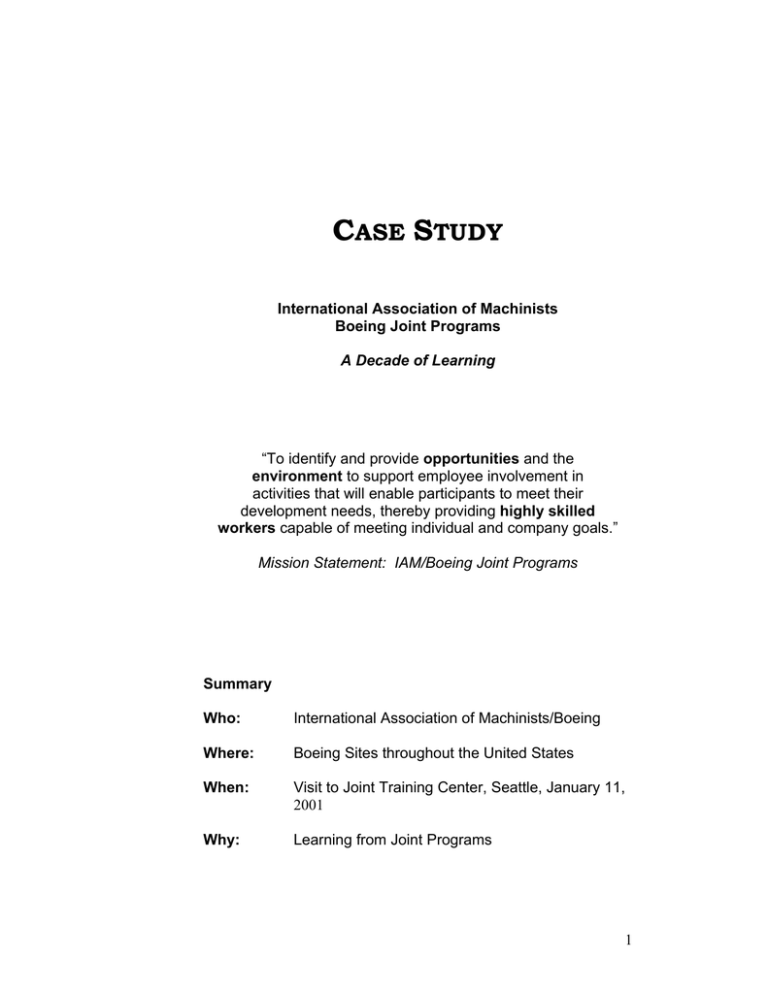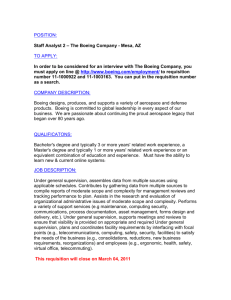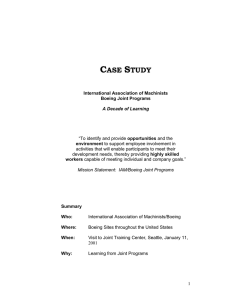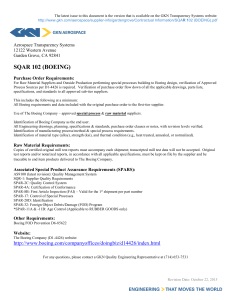
CASE STUDY
International Association of Machinists
Boeing Joint Programs
A Decade of Learning
“To identify and provide opportunities and the
environment to support employee involvement in
activities that will enable participants to meet their
development needs, thereby providing highly skilled
workers capable of meeting individual and company goals.”
Mission Statement: IAM/Boeing Joint Programs
Summary
Who:
International Association of Machinists/Boeing
Where:
Boeing Sites throughout the United States
When:
Visit to Joint Training Center, Seattle, January 11,
2001
Why:
Learning from Joint Programs
1
Overview
The paragraph on the title page summarizes the goals of language first
inserted in the 1989 collective bargaining agreement between the
International Association of Machinists and Aerospace Workers
(IAM) and the Boeing Corporation. It grew out of a year of informal
discussions among Boeing executives and IAM representatives over
how to give new life to what was then its rather ineffective
“technology” committee language in Article 20 of their contract.
While the language in the old article called for the company and union
to work together to introduce new technology and involve the
workforce, in reality not much of this was being done. Nor were there
resources available to support such efforts. Moreover, the union
leadership was wary of entering into joint programs with the company
because its international union had a general distrust of management
initiated “quality circles” or other processes that it feared would erode
worker rights or drive a wedge between members and their union.
Both management and labor leaders, however, recognized the need to
introduce and adapt to technological change to keep the company
competitive and generate new opportunities. Both agreed that this was
a practical and focused area of shared interest where a collaborative
effort made sense. Moreover, as part of the joint study process that
preceded the 1989 negotiations, the parties examined other joint
training programs already in place, most notable those between the
United Auto Workers and the Big
Three auto companies, and between Both management and labor
AT&T and the Communications leaders… recognized the
Workers of America.
From these need to introduce and adapt
efforts, the parties jointly developed to technological change to
new language for Article 20. Excerpts keep the company
of this article and its accompanying competitive and generate
letter of understanding are provided in new job opportunities.
Figure 1.
The purpose of this brief note is to describe how this joint program has
evolved over its first decade of experience. It is not an evaluation or
assessment of the program. Instead, we present it here only to
illustrate the potential of this type of joint effort for bringing life long
learning to hourly workers in a world of continuous technological and
2
organizational change. We end by speculating about how the program
might step up to the next level of development and impact.
Basic Design Features
The IAM/Boeing Joint Programs are financed by a fund that receives
14 cents per payroll hour for all bargaining unit employees. In 1992,
the company and union agreed to ensure a $14 million minimum
annual budget in the event that the payroll hour formula falls below
this threshold. Additional funds beyond these levels are provided to
cover the costs of the employee tuition assistance plan. Funds not
spent in a calendar year are carried over to the next year. In 1999, the
budget for the Joint Programs was approximately $25 million. “This is
a high level of funding but the importance and credibility of the
training program is highlighted even more with the news that even in
the current period of downturn, the company has allocated an
additional $1.25 million based on the program’s proven value.” Gary
Jackson, QTTP IAM Co-Director from District 751 explained that
each shop floor area has its own performance metrics that reflect the
added value of the training programs. Floor managers now come and
ask for help because of the levels of performance in other areas.
Facilities in three states, Washington, Oregon and Kansas, currently
have QTTP initiatives underway. They are governed by a board
consisting of international and district level union representatives, plus
company line and employee and union relations executives. The
company and union each appoint an executive director who oversees a
full time staff.
The staff is responsible for “developing,
recommending and implementing training programs”. They use
internal and external resources for curricular development and
instruction. A critical aspect of this program is its linkage to the shop
floor through the input and participation of shop floor managers and
hourly workers in the development and implementation of training.
Training topics and needs are determined by the recommendations
from the shop floor.
Evolution and Expansion
Among the Joint Programs’ initiatives are six of primary interest to
this case study:
Layoff and Redeployment Assistance. The first several years of the
program were focused on providing training opportunities for laid-off
Boeing employees. This reflected the most pressing issue of the early
1990’s as cuts in defense spending and the effects of the 1991-1992
recession reduced demand for Boeing’s military and commercial
3
products and produced significant layoffs. Laid-off employees are
entitled to up to $2,500 a year for educational assistance. Employees
eligible for government training funds under the Trade Adjustment Act
(where the layoff was determined to be caused by foreign competition)
must exhaust these public funds before drawing on their Boeing
benefits. From time to time, the company and union have also
obtained supplemental training funds from other government
programs.
The Health and Safety Institute. The HIS provides a range of training
and related services for individuals and site safety committees. Site
committees, for example, are training to perform accident
investigations and safety audits, and can draw on the HIS video,
display, and other employee communication resources. HIS also
contracts with an outside organization that provides rehabilitation
training to injured employees seeking to return to work. Both Wichita
and Puget Sound locations use mobile training trailers to deliver safety
training to employees at diverse locations. A major initiative aimed at
building a stronger safety culture has just been launched at Boeing’s
Wing Responsibility Center in Fredrickson, Washington.
Career and Personal Development.
The Career and Personal
Development services offered under the program are perhaps the most
sophisticated of any in the country. Active employees can receive
payment of the full costs of tuition and books for courses and/or
classes that are regionally or nationally accredited as well as up to
$2,000 ($2,500 for laid-off workers) tuition assistance for nonaccredited courses. Allowing employees to choose what to study
represented a shift from an earlier company tuition assistance program
that required two levels of management to certify that a proposed
course was job relevant. Under that program, payment was made only
after providing evidence the course was completed successfully. Only
300 hourly employees participated in that program in the three years
prior to the beginning of the current program.
Tables 1 and 2 chart the usage rates under the new tuition assistance
program for 1996 through 2000. Over this time more than 23,000
individuals participated in the educational assistance program,
receiving course vouchers for approximately 35,500 courses. There
was some fear (and some criticism) that allowing people to take
courses they chose would lead many employees to use the funds to
pursue personal hobbies or other courses of dubious career relevance.
This has not been the experience to date. As Figure 3 shows,
computer classes consistently rank as the top course selection, with
courses on hobbies ranking at or near the bottom of the list of courses
taken.
4
One of the most innovative career services offered by
One of the most
the joint program is its career advising and planning
innovative
initiative. By integrating a thorough analysis of the
career services
qualifications of the jobs open to hourly workers with
offered by the
personal counseling, aided by a simple but flexible
joint program is
computer-based training, certification, and application
its career
system, the program has built a state-of-the-art
advising and
individual career assessment and planning tool.
planning
Program staff, many of whom are union members,
conducts on-site assessments and employee interviews initiative.
to identify the knowledge, skills, and abilities required to
qualify for different bargaining unit jobs. This information is then
translated into a list of courses or skills certifications employees must
have to apply for each position. These data are then placed on the
program’s website. Interested employees can scan the website for
these jobs and see the list of courses and/or certifications that are
needed to apply for different positions. Then, employees can sit down
with a job counselor and use the web based information and software
to create individual training plans that show the requirements they
have met and those courses or “challenge” exams they need to
complete before being eligible to file an Employee Request for
Transfer (ERT) for a given position. The system also can tell
employees how many others have applied for a given position, thus
allowing an assessment of their chances of bidding successfully for the
jobs available. As of November 6, 2001, guides for 832 different
bargaining unit jobs have been completed (with the balance to be
completed in 2002). The plan is to have all the bargaining unit jobs
analyzed and on line within the next year. When completed, this
should be an extremely useful tool for creating individual career plans
for individual employees.
Classroom Training. Some classroom instruction is provided on site
and some at various community colleges and technical schools. One
course the parties are most proud of teaches employees American Sign
Language (ASL). Interest in this course came from a number of coworkers in a unit with several hearing impaired employees. These coworkers wanted to learn how to communicate with their colleagues by
learning ASL. Out of this has now come a tailored course in which
instructors and employees have developed signs for a number of shopspecific, or Boeing specific, technical terms used on their jobs. It is
not uncommon to find employees without hearing impairments using
this mode of communicating in operations where noise levels make
verbal communication difficult.
5
Personal Enrichment. Personal Enrichment classes also get high
marks from employees and unit managers. These courses focus
largely on the behavioral and group process skills needed to work
together in teams and in problem solving processes. They cover topics
such as communications, group dynamics, negotiations and conflict
resolution, motivation, self-esteem, and leadership. These have been
used in specific areas where considerable change and job consolidation
are taking place and can be tailored to fit the specific challenges or
issues facing a particular group.
High Performance Work Organization. Gradually, over the first ten
years of its evolution, the joint programs have expanded to support
other company and union initiatives. The most recent is the High
Performance Work Organization (HPWO) program that the IAM and
Boeing are working to get off the ground. HPWO is a joint unionmanagement effort to foster employee participation on the critical
issues affecting jobs and the competitiveness of the company. The
first major effort to initiate a HPWO is underway in Boeing’s Wichita
operations. The company is committed to providing additional
resources as required for training and other supports as this program
expands.
Next Step?
About a decade after they were launched, the IAM/Boeing Joint
Programs have achieved considerable size and scope, reaching
somewhere between 40 and 50 percent of bargaining unit employees.
Yet these programs are far from reaching their full potential.
Consider, for example, their relationship to another major Boeing
initiative, lean production. Boeing, like most other manufacturing
companies, has a major effort underway to implement principles of
lean production – low inventories, less work in process, reduced cycle
time between customer orders and product delivery, improved work
flow, efficient use of space, etc. Inevitably, implementing these
principles requires considerable organizational change, job
consolidation, and employee participation. Yet most of the lean
initiatives at Boeing are conceived and led by operations managers and
engineers, with relatively little employee input. In one labor intensive
component manufacturing operation, for example, a line manager who
articulated a very clear vision of the changes that needed to be made to
implement lean principles was asked if he knew of the QTTP program.
He had only a vague idea of what this was and had no plan to make
use of it in the change efforts in his area. When asked how the job
combination process would play out as they undertook the changes
planned, he said: “We will soon hit the wall. Given the changes in
6
processes and job considerations they will entail, we’ll end up with a
lot of arbitrations.”
For their part, joint program staff members are also reluctant to get too
deeply involved in this type of effort, particularly once a change
process has been started and grievances over job changes or other
contractual issues have been filed. As the co-chairs of the program
stated in an interview, “We are careful not to go there [into contractual
or grievance issues or disputes].”
So, the question is: Would it be possible to bring the resources and
various components of the joint training programs to bear on lean
production or related organizational change initiatives? Joint training
for workers, union representatives, area supervisors and managers
about to embark on a lean implementation project could be provided,
tailored to the specific problems they are likely to encounter.
Individual employee career assessment and training plans could be
developed to assess the breadth and depth of skills available for the
new jobs and options for employees whose current jobs are changed or
eliminated.
Summary
The joint training programs have a number of attractive design features
for promoting and extending life-long learning opportunities to the
hourly workforce. A steady stream of funds are provided via the
hourly payroll formula and the parties have seen fit
to establish a minimum budget to assure that …the joint training
adequate funding is available if work hours fall programs have a
below a certain threshold. The program is jointly number of
governed and staffed and thereby provides shared attractive design
ownership and buy-in from management, the union, features for
and the workforce. This helps it avoid being held promoting and
hostage to the ups and downs of normal labor extending life long
relations -- union elections, bargaining rounds, learning
management and/or union leadership turnover, etc. opportunities to the
It is flexible and can be demand driven, as illustrated hourly workforce.
by the ASL and Personal Enrichment classes. It can
take on specific high priority concerns such as health and safety
training, HPWO training, and if the parties choose to use it for this
purpose, lean production training. It can support career development
and life-long learning for both current employees and those on lay off.
Several challenges face this program despite its high level of creative
and excellent programming. Its full potential will be realized only
when line managers and shop stewards in different areas of Boeing’s
7
vast operations see it as a natural resource to be used to assist in
whatever set of organizational and/or technological changes they
anticipate or experience. Moving to this next level of development is
one of the challenges and opportunities facing this innovative unionmanagement learning and change initiative. Despite the superb
program supported by Boeing and the IAM, it can still be held hostage
to industry instability cycles and the rapid advances in technology.
8
Figure 1
Excerpts from Article 20 – Quality Through Training
The Union and the Company agree that it is to their mutual benefit, in a
competitive global economy and environment of rapid technological
innovation and change, to work together to improve the quality of work life
and productivity. The parties, utilizing participative principles, will offer a
diverse range of opportunities for training, retraining, and personal growth
diverse range of opportunities for training, retraining, and personal growth to
enhance employee development and satisfaction and support, increased
market share, and improved economic performance of the Company.
It is in the interests of the parties to develop and implement a wide variety of
mutually agreeable training, education, and learning programs that serve as
well as support other joint activities. These activities will…target training in
the following areas: (1) for employees who may be impacted or have their
job duties and responsibilities affected by technology changes and/or job
combinations; (2) for employees who wish to meet their individual
career/personal development goals; (3) for laid-off employees to enable them
to become better qualified for employment within or outside the Company;
(4) for employees who are involved in High Performance Work
Organizations (HPWO).
General direction and guidance of the IAM/Boeing Quality Through Training
Program (QTTP) shall be the responsibility of the IAM/Boeing Joint
Programs National Governing Board [consisting of four international and
district officers of the IAM and four company executives, including the Vice
President of Operations and the Vice President of Employee and Union
Relations].
The parties agree that the Company will provide the necessary funding in
support of the …HIS, QTTP, and other activities approved by the
IAM/Boeing Joint Programs National Governing Board…
The Company will spend in each year fourteen (14) cents for each bargaining
unit compensated hour, but not less than fourteen (14) million dollars per
year. In addition, the Company will provide funding for the QTTP
Education Assistance Program up to four (4) million dollars per year.
Amounts not spent in one annual period shall carry over to the next year, but
not beyond the expiration of the Agreement. Additionally, the Company will
provide training transition funds and other funds, approved by the Governing
Board, to support the Joint Programs’ statement of work.
----------------------------Sources: Article 20 and Letter of Understanding No. 20 of the 1999
Collective Bargaining Agreement.
9
Figure 2
Activities Supported by the Joint Program
Career and Personal Development
Job Combinations
Technology Change
High Performance Work Organization Initiatives
Laid-off and Reemployment Training and Services
Industrial Skill Training
Certification and Regulatory Requirements’ Training
Transfer Process Improvement and Support
Support for “The Mutual Objectives of the Union and the Company”
10
Figure 3
Leading Course Selections under the Educational Assistance
Program
1998
Computer
Machinist
Aviation
Math
Science
Business/Office
Foreign Language
Communications
English/Reading
Hobbies
1999
Computer
MCSE
Math
Communications
Aviation
Business/Office
Science
English/Reading
Hobbies
Foreign Language
2000
Computer
Safety Shoes
MCSE
Math
Communications
Business/Office
English/Reading
Hobbies
Science
Aviation
11
Table 1: Education Assistance Participants
1996 through 2000
9000
8000
7000
6000
5000
4000
3000
2000
1000
0
12
1996
1997
1998
1999
2000
Table 2: Education Assistance Vouchers
1996 through 2000
12000
10000
8000
6000
4000
2000
0
1996
1997
1998
1999
2000
13
14
Teaching Notes
It is people who are at the heart of new work systems – establishing
stability and then driving continuous improvement. The Labor
Aerospace Research Agenda (LARA) at MIT is committed to furthering
our understanding of the human and institutional aspects of these new
work systems, especially as they relate to broader issues of
employment and vitality in the aerospace industry.
These case studies were written by a MIT-based research team and
were developed in conjunction with representatives from each of the
sites with the help of representatives of the United Auto Workers and
the International Association of Machinists.
These case studies will be valuable to union leaders, labor educators,
college professors and human resource trainers as well as anyone
interested in discussing current dilemmas in the aerospace industry
around employment. These can be used in a classroom setting, in
small discussion groups, or by individuals as thought starters. This
case study was prepared as an example of the challenges of instability
in the aerospace industry. It was written as a basis for dialogue and
learning, not as an illustration of either effective or ineffective actions.
There may be many possible answers to these questions. They are
designed to foster constructive dialogue and action on these very
challenging issues.
Potential Discussion Questions
•
How does the establishment of a joint training fund help to
advance the core mission of the union? How does it help to
advance the core mission of the employer?
•
In what ways does a joint training fund serve both parties better
than the traditional forms of internal training provided
separately by the employer and the union?
•
What are the limitations of the joint training model?
•
Could a funding stream for joint training be established in your
location similar to this case? What protections and
understandings would be required for labor and management?
•
Or, if you have such a funding stream, how is it functioning?
15
•
How would you compare and contrast the use of joint
training funds for each of these topics mentioned in the
case:
Layoff and Redeployment Assistance
The Health and Safety Institute
Career and Personal Development
Classroom Training
Personal Enrichment
High Performance Work Organization
•
Which of these topics are likely to be more or less
difficult to deliver?
•
Which are going to be more or less difficult to
administer on a joint basis?
•
What other topics might be appropriate for
consideration under a joint training fund?
Thomas A. Kochan prepared this case that has subsequently been
updated by Betty Barrett. Other members of the LARA team provided
additions. This case study is an example of the challenges of
instability in the aerospace industry and was written as a basis for
dialogue and learning – not as an illustration of either effective or
ineffective actions.
Copyright© 2001 Labor Aerospace Research Agenda. Massachusetts
Institute of Technology. All rights reserved. To order copies of this
case study, obtain a listing of LARA case studies, or to request
permission to reproduce materials, please email laraproject@mit.edu, write
to the Labor Aerospace Research Agenda, Center for Technology,
Policy, and Industrial Development, MIT, 1 Amherst Street,
Cambridge, MA 02139 or call (617) 258-7207. Version 5.1
16







